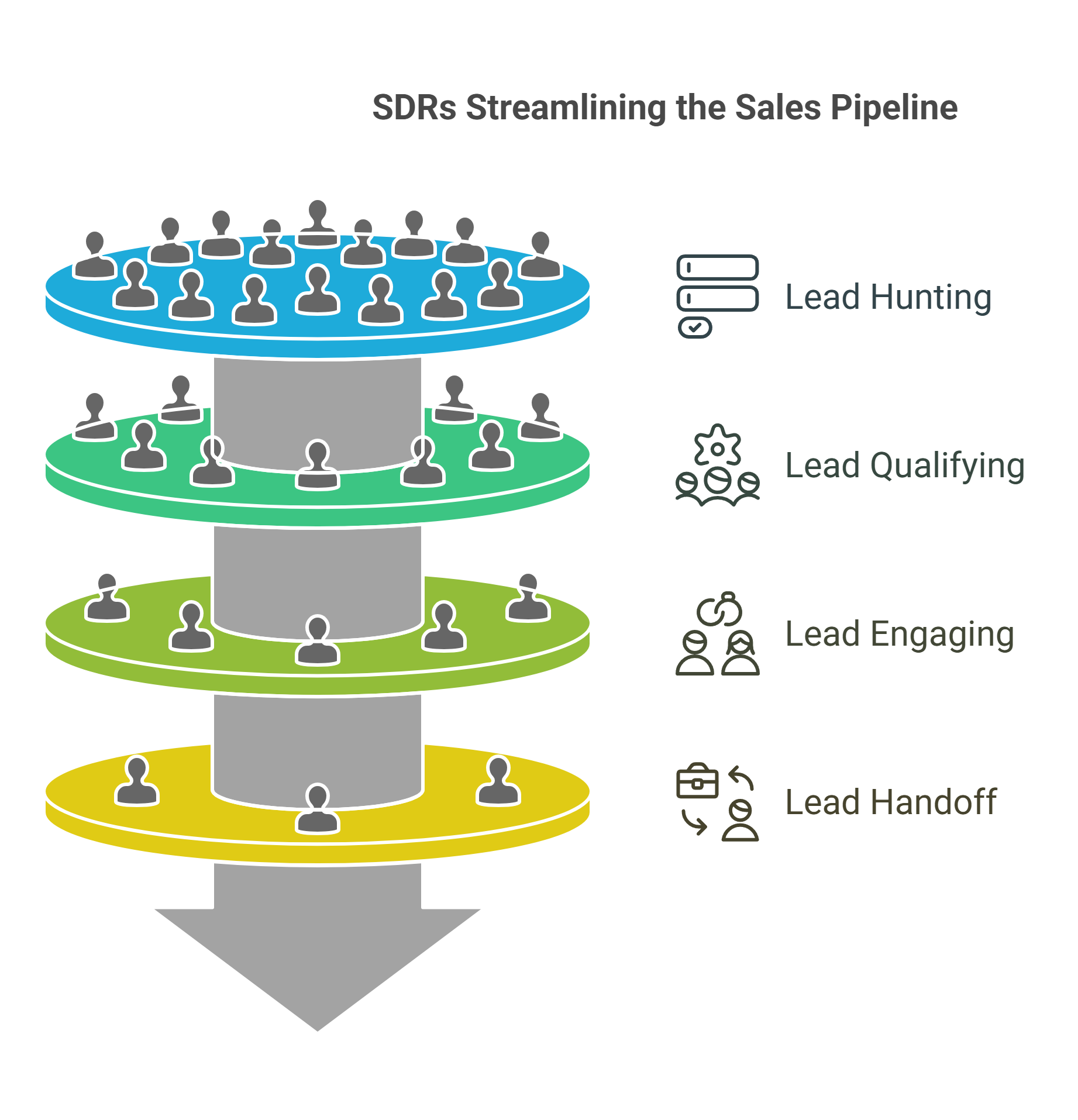Ever wondered who the rockstars are behind the scenes of a killer sales strategy? Meet the Sales Development Representatives (SDRs)—the unsung heroes bringing potential customers right to your doorstep. These pros are the first point of contact in many sales cycles, paving the way by reaching out, starting conversations, and setting the stage for the big sales magic to happen.
But SDRs are no longer just “cold callers.” Thanks to the evolving B2B sales game, their role has grown into a powerful driver of business success. Let’s dive into why SDRs are so important and how they impact the entire sales journey.
Why Are SDRs Crucial for Your Sales Process?
Think of SDRs as the glue holding a company’s sales process together. They’re the middle ground between a company’s marketing efforts and its sales team and are vital for optimizing the sales cycle. Here’s why:
- Building the First Connection: SDRs are often the first ones to reach out to potential leads. They’re making that all-important first impression, shaping how a prospect views your company and your solution.
- Saving Time for Closers: SDRs qualify leads—assessing which prospects are worth handing over to the sales team. This helps your Account Executives (AEs) focus on closing deals instead of chasing dead-ends.
- Better Quality Leads: By carefully nurturing and qualifying prospects, SDRs ensure the sales team gets high-quality, ready-to-buy opportunities.
If the sales funnel were a relay race, SDRs are the first leg—lining up the baton for an easy handoff.

SDRs & Lead Generation: The Dynamic Duo
Leads are the bread and butter of any SDR’s work, and these folks are masters at sniffing out potential business opportunities. Here’s how they do it:
- Hunting for Prospects: SDRs dig through market data, follow industry trends, and conduct tons of research to find promising leads (aka people who might become customers).
- Qualifying Leads: Not every lead is worth chasing. SDRs use their best detective skills to figure out which prospects are gold and which ones aren’t worth the effort.
- Engaging With Prospects: Whether it’s a personalized email, a phone call, or a quick chat on LinkedIn, SDRs strategically nurture these prospects until they’re ready to talk business.
It’s not about casting a wide net—it’s about casting the right net at the right fish.
Best Practices That Make SDRs Stand Out
So, how do SDRs manage to cut through all the noise and grab the attention of busy decision-makers? Let’s talk strategy:
- Personalization is Everything
Nobody likes copy-paste pitches. SDRs dig deep into prospect research to craft personalized messages that hit the right note. - Using Multiple Channels
SDRs are pro multitaskers. They use everything—emails, phone calls, social media (hello LinkedIn)—to reach prospects where they already are. - Value-Driven Messaging
Instead of talking features, SDRs focus on solving problems. Their messages highlight how your product or service makes the lead’s life easier.
The goal? To start meaningful conversations, not just sell something off the bat.

How SDRs and AEs Work Together
SDRs and Account Executives are like Batman and Robin: individually talented but downright unstoppable as a team.
- Smooth Handoffs: SDRs make sure leads are fully prepped for AEs, ensuring a seamless transition.
- Team Goals: Both SDRs and AEs work toward the same sales goals. Regular sync-ups help align strategies.
- Strategic Insights: SDRs provide AEs with crucial info about leads, like pain points and key objections, so the AE can build on these insights during sales meetings.
When they work in harmony, SDRs set the sales stage while AEs take the spotlight and bring it home.
SDRs in the Sales Pipeline
Here’s how SDRs move leads through the sales funnel:
- Engaging Early: They establish contact with new prospects and actively nurture them.
- Educating Prospects: SDRs share relevant data, case studies, or industry insights to keep prospects interested.
- Qualifying and Passing Leads: After determining which leads are ready-to-buy, SDRs schedule follow-up meetings or demos with AEs.
In short, SDRs aren’t just booking meetings—they’re sowing the seeds for long-term revenue success.
Top Tools Every SDR Needs
Want to know the secret sauce to SDR success? It’s technology! SDRs rely on tools like:
- CRM Systems: These tools track every prospect interaction, keeping everything organized.
- Automation Software: Automating follow-ups and other repetitive tasks frees up SDRs for meaningful conversations.
- Sales Analytics: SDRs leverage data to fine-tune their outreach strategies and predict outcomes.
With the right tech stack, SDRs can be even more productive—and effective.
Career Growth for SDRs
The SDR role is the perfect launchpad for bigger opportunities. Many SDRs move on to positions like:
- Account Executive (AE): Ready to close deals and manage key accounts? An SDR role is the perfect training ground.
- Sales Manager: Lead a team of SDRs and shape the future of your sales team.
- Marketing, Customer Success, or Product Management: The skills SDRs develop—like understanding customer pain points—translate well into other fields.
Starting as an SDR is often just the beginning in the world of B2B sales.
FAQ: Sales Development Representatives
Q: What’s the main job of an SDR?
A: SDRs identify and qualify potential customers, then tee them up for the sales team to close deals.
Q: What tools do SDRs use daily?
A: SDRs rely on CRM systems, automation tools, and sales analytics platforms to stay on top of their game.
Q: How do SDRs and Account Executives work together?
A: SDRs warm up leads, then pass them to AEs, who focus on closing deals. They’re a tag team driving the sales process.
Q: Can SDRs move into other career paths?
A: Absolutely! Many SDRs grow into AEs, Sales Managers, or roles in marketing, customer success, and beyond.
Q: Why are SDRs so vital for revenue growth?
A: By focusing on generating and qualifying high-quality leads, SDRs free up sales teams to focus on closing deals—streamlining the entire process.
SDRs are truly the backbone of modern B2B sales. They hustle hard to ensure sales teams are primed for success and, in doing so, help drive revenue and business growth. Keep that in mind next time you’re on the receiving end of a sales email—they’re doing a lot more than just saying hello.







